

In long LED runs, voltage drop can cause dimming and uneven lighting. I’ll show you why accurate calculations matter, how to use our interactive calculator widget, and guide you through worked examples and downloadable tools to ensure your strips shine at full brightness.
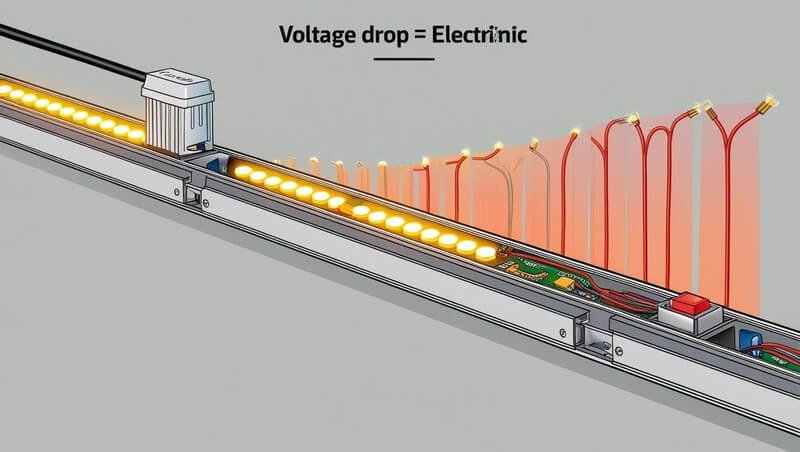
Voltage drop occurs when electrical current flows through the resistance of wires and LED strip traces, causing the voltage at the end of a run to be lower than at the source. In LED strips, long cable runs or undersized wire gauge amplify this effect, leading to dimmer LEDs and uneven brightness. To calculate drop, you multiply the current (I) by the total resistance (R) of the conductors over the run length (L).
On a standard 12 V LED strip, three LEDs share a single resistor. Each LED typically has a forward voltage of ~2.2 V (red) to ~3.2 V (green/blue), averaging around 3 V per LED. The resistor drops the remaining voltage to maintain safe current levels.
Key takeaway: Voltage drop is driven by current×resistance, and understanding each LED’s forward voltage (~3 V) helps you size wiring and resistors correctly.
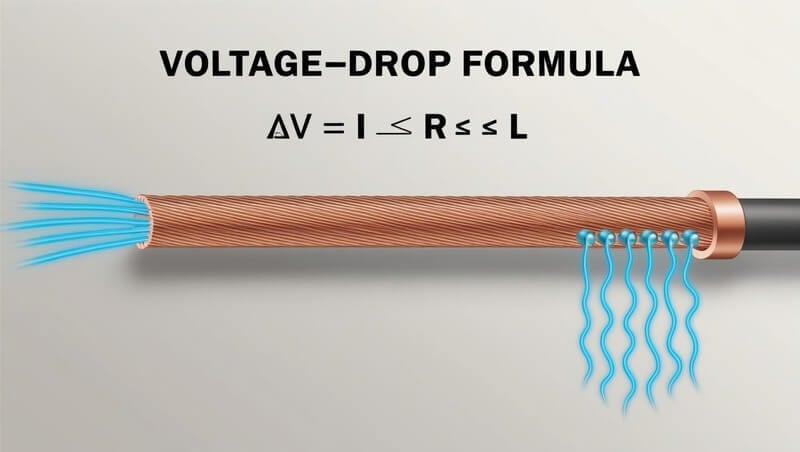
Calculating voltage drop helps you prevent dimming and ensures even brightness. The basic formula is:
ΔV=I×R×L\Delta V = I \times R \times L
For LED strips drawing 2 A per metre (≈ 24 W/m at 12 V), multiply the wire’s resistance by 2 A and the length to find the total drop.
Selecting the correct wire gauge minimizes voltage drop. Below is a reference table for common AWG sizes, their resistance per metre, and the resulting voltage drop at 2 A per metre:
| Wire Gauge (AWG) | Resistance (Ω/m) | Voltage Drop (V/m at 2 A) |
| 16 AWG | 0.01317 | 0.0263 |
| 14 AWG | 0.00829 | 0.0166 |
| 12 AWG | 0.00521 | 0.0104 |
| 10 AWG | 0.00328 | 0.0066 |
Data source: Southwire AWG resistance chart.
Table T1 provides wire resistance and expected voltage drop per metre at a 2 A load.
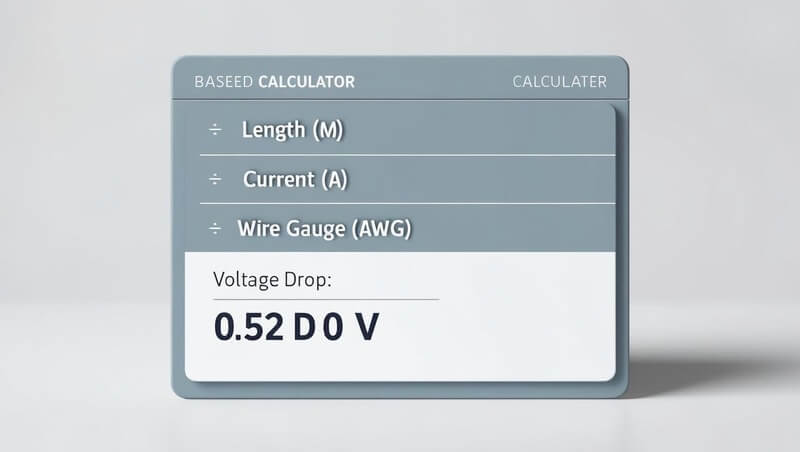
Our interactive calculator lets you instantly compute voltage drop without manual math. Simply enter the run length (m), current draw (A), and select your wire gauge (AWG) to see the voltage loss in real time. The widget validates inputs, displays ΔV immediately, and updates as you tweak values—ideal for planning runs of any length or wattage.
If you prefer offline tools, download the PDF or Excel versions in the next section.
Instant, user-friendly widget for accurate LED strip voltage-drop calculations.
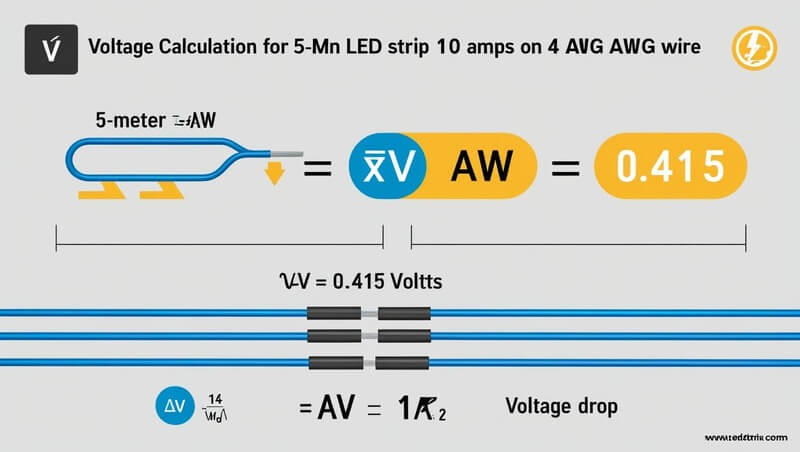
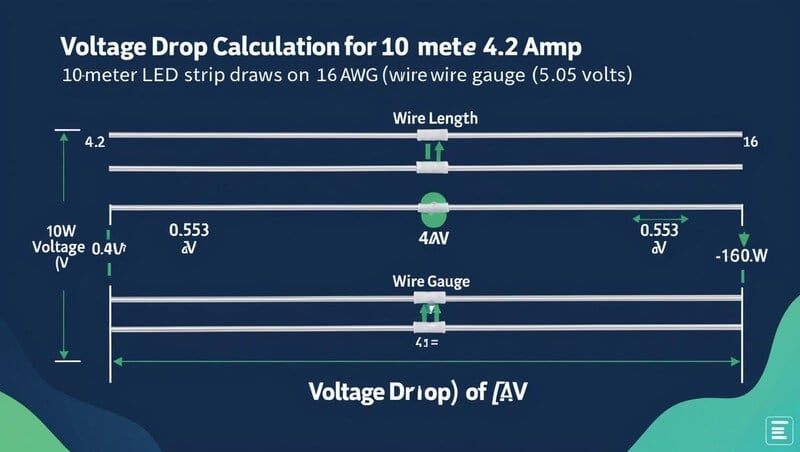
When voltage drop causes dimming or uneven brightness, try these solutions:
For detailed wiring diagrams and best practices, see our LED Strip Wiring Guide.
Key takeaway: Strategic power injection, proper wire gauge, and clean connections prevent voltage-drop issues and keep your شرائط LED uniformly bright.
How do you calculate the voltage drop of LED strip lights?
Use the formula ΔV = I × R × L, where I is total current (amps), R is conductor resistance per metre (Ω/m), and L is run length (m). You can also enter these values into the interactive calculator or downloadable spreadsheet for instant results.
How much voltage does one LED drop?
On a typical 12 V LED strip, three diodes share a resistor. Each LED’s forward voltage is about 2.2 V (red) to 3.2 V (green/blue), averaging roughly 3 V per LED. The resistor then drops the remaining voltage to regulate current.
What wire gauge should I choose to minimize voltage drop?
Select wire gauge based on run length and current draw. For a 5 m strip at 2 A/m, 14 AWG keeps drop under 5 %. For longer runs or higher amperage, use 12 AWG or 10 AWG. Refer to the wire‐gauge table (T1) or our calculator for precise recommendations.
How can I reduce or mitigate voltage drop issues in my LED installation?
Prevent dimming by injecting power at both ends or every 3–5 m, using thicker‐gauge wire, splitting long runs into shorter segments, wiring strips in parallel, and adding a 1 000 µF capacitor at the start of each run.
Our LED Strip Voltage Drop Calculator equips you to design flawless installations—avoiding dimming, choosing the right wire gauge, and planning power injection points. Use the embedded widget above for instant results, download the PDF/Excel tools for offline planning, and watch the demo video for a guided walkthrough.
For detailed wiring diagrams, consult our LED Strip Wiring Guide; to explore compatible hardware, visit our ملحقات شرائط الصمام الثنائي الباعث للضوء LED collection.
Key takeaway: Accurate voltage-drop calculations and proper wiring practices ensure your LED strips shine at full brightness and uniformity.